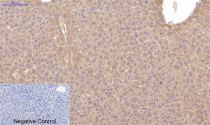ARG66888
anti-Caspase 3 (cleaved) antibody
anti-Caspase 3 (cleaved) antibody for ICC/IF,IHC-Formalin-fixed paraffin-embedded sections,Western blot and Human,Mouse,Rat
Cancer antibody; Cell Biology and Cellular Response antibody; Cell Death antibody; Neuroscience antibody; Apoptosis Marker antibody; Mitochondria/Caspase Dependant Apoptosis Marker antibody
Overview
| Product Description | Mouse Monoclonal antibody recognizes Caspase 3 (cleaved) |
|---|---|
| Tested Reactivity | Hu, Ms, Rat |
| Tested Application | ICC/IF, IHC-P, WB |
| Host | Mouse |
| Clonality | Monoclonal |
| Isotype | IgG1 |
| Target Name | Caspase 3 (cleaved) |
| Antigen Species | Human |
| Immunogen | Recombinant protein of cleaved Caspase 3. |
| Conjugation | Un-conjugated |
| Alternate Names | CASP3; Caspase 3; Apopain; CPP32; CPP32B; Caspase 3, Apoptosis-Related Cysteine Peptidase; Caspase 3, Apoptosis-Related Cysteine Protease; SREBP Cleavage Activity 1; Cysteine Protease CPP32; Protein Yama; EC 3.4.22.56; Caspase-3; CASP-3; CPP-32; SCA-1; Yama; PARP Cleavage Protease; Procaspase3; EC 3.4.22 |
Application Instructions
| Application Suggestion |
|
||||||||
|---|---|---|---|---|---|---|---|---|---|
| Application Note | * The dilutions indicate recommended starting dilutions and the optimal dilutions or concentrations should be determined by the scientist. | ||||||||
| Positive Control | HeLa, NIH/3T3 and Rat brain | ||||||||
| Observed Size | ~ 20 kDa (cleaved form) |
Properties
| Form | Liquid |
|---|---|
| Purification | Affinity purification with immunogen. |
| Buffer | PBS (pH 7.4), 0.02% Sodium azide, 50% Glycerol and 0.5% BSA. |
| Preservative | 0.02% Sodium azide |
| Stabilizer | 50% Glycerol and 0.5% BSA |
| Storage Instruction | For continuous use, store undiluted antibody at 2-8°C for up to a week. For long-term storage, aliquot and store at -20°C. Storage in frost free freezers is not recommended. Avoid repeated freeze/thaw cycles. Suggest spin the vial prior to opening. The antibody solution should be gently mixed before use. |
| Note | For laboratory research only, not for drug, diagnostic or other use. |
Bioinformation
| Database Links | |
|---|---|
| Gene Symbol | CASP3 |
| Gene Full Name | caspase 3, apoptosis-related cysteine peptidase |
| Background | The protein encoded by this gene is a cysteine-aspartic acid protease that plays a central role in the execution-phase of cell apoptosis. The encoded protein cleaves and inactivates poly(ADP-ribose) polymerase while it cleaves and activates sterol regulatory element binding proteins as well as caspases 6, 7, and 9. This protein itself is processed by caspases 8, 9, and 10. It is the predominant caspase involved in the cleavage of amyloid-beta 4A precursor protein, which is associated with neuronal death in Alzheimer's disease. [provided by RefSeq, Aug 2017] |
| Function | Cleaves XRCC4 and phospholipid scramblase proteins XKR4, XKR8 and XKR9, leading to promote phosphatidylserine exposure on apoptotic cell surface. [UniProt] |
| Cellular Localization | Cytoplasm. [UniProt] |
| Highlight | Related Antibody Duos and Panels: ARG30105 Apoptosis Marker Antibody Duo (Caspase3, PARP) ARG30110 Mitochondria/Caspase dependant Apoptosis Antibody Panel (Caspase3, Caspase9, Cytochrome c, PARP) (WB) Related products: Caspase 3 antibodies; Caspase 3 Duos / Panels; Anti-Mouse IgG secondary antibodies; |
| Research Area | Cancer antibody; Cell Biology and Cellular Response antibody; Cell Death antibody; Neuroscience antibody; Apoptosis Marker antibody; Mitochondria/Caspase Dependant Apoptosis Marker antibody |
| Calculated MW | 32 kDa |
| PTM | Acetylation, Phosphoprotein, S-nitrosylation, Zymogen. [UniProt] |
Images (6) Click the Picture to Zoom In
-
ARG66888 anti-Caspase 3 (cleaved) antibody ICC/IF image
Immunofluorescence: HeLa cells stained with ARG66888 anti-Caspase 3 (cleaved) antibody (green) at 1:200 dilution and co-stained with ARG51617 anti-FOXO1 / FKHR phospho (Ser256) antibody (red) at 1:200 dilution, overnight at 4°C.
-
ARG66888 anti-Caspase 3 (cleaved) antibody IHC-P image
Immunohistochemistry: Paraffin-embedded Human liver tissue stained with ARG66888 anti-Caspase 3 (cleaved) antibody at 1:200 dilution, overnight at 4°C. Antigen Retrieval: Boil tissue section in Sodium citrate buffer (pH 6.0) for 20 min. Negative control was used by secondary antibody only.
-
ARG66888 anti-Caspase 3 (cleaved) antibody WB image
Western blot: HeLa, NIH/3T3 and Rat brain lysates stained with ARG66888 anti-Caspase 3 (cleaved) antibody.
-
ARG66888 anti-Caspase 3 (cleaved) antibody IHC-P image
Immunohistochemistry: Paraffin-embedded Rat lung tissue stained with ARG66888 anti-Caspase 3 (cleaved) antibody at 1:200 dilution, overnight at 4°C. Antigen Retrieval: Boil tissue section in Sodium citrate buffer (pH 6.0) for 20 min. Negative control was used by secondary antibody only.
-
ARG66888 anti-Caspase 3 (cleaved) antibody IHC-P image
Immunohistochemistry: Paraffin-embedded Mouse liver tissue stained with ARG66888 anti-Caspase 3 (cleaved) antibody at 1:200 dilution, overnight at 4°C. Antigen Retrieval: Boil tissue section in Sodium citrate buffer (pH 6.0) for 20 min. Negative control was used by secondary antibody only.
-
ARG66888 anti-Caspase 3 (cleaved) antibody IHC-P image
Immunohistochemistry: Paraffin-embedded Human tonsil tissue stained with ARG66888 anti-Caspase 3 (cleaved) antibody.













